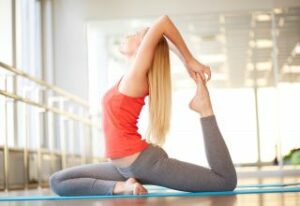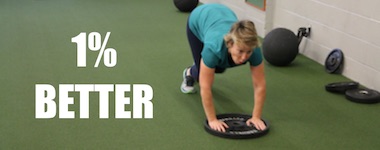Hope you are having a great day so far! I wanted to share with you a simple technique you can do to increase flexibility and its not what you are thinking. We have introduced a technique called RPR to our regular warm ups and personally I have never felt better.
 Let’s do a quick experiment. Stand up! Bend at the waist and do a toe touch. Where do your hands land? Did you touch the floor? Are your fingertips at your knees? It doesn’t matter. This is our baseline.
Let’s do a quick experiment. Stand up! Bend at the waist and do a toe touch. Where do your hands land? Did you touch the floor? Are your fingertips at your knees? It doesn’t matter. This is our baseline.
Now – put a palm high on your chest and take ten quick mouth breaths up high into your chest. How’s that feel? Now test against that baseline. Where’d you end up?
Ok, shake it out and put your palm on your stomach just below your belly button. Now take ten breaths down into your belly, in through your nose and out through your mouth. How’s that feel? Now test again against that baseline. Any change?
If you’re like just about everyone that I’ve ever done this with, you discovered that “stretching your hamstrings” isn’t remotely as effective as just taking a few good breaths.
Generally, this comes with a simple question: “What the heck just happened?”
To answer this, we’re going to get deep.
What is Stretching:
Under that mechanical paradigm, when we stretch, we are thinking of the muscle like a rubber band – we are pulling on it and it responds by lengthening. We can sum it up by saying that length and tension are the output of our intentional actions related to that muscle.
If we take apart the action of stretching, we can get a clue into what’s really happening.
There is a neural signal between the brain and the muscles which governs how much range of motion will be available. It is not conscious, it is our subconscious mind (our nervous system) which dictates the safe zone of movement based on the structures, the muscles, and our history.
When we run into the edge of that zone and try to push past it, we either find that we can’t (“Ugh, my hamstrings are SO TIGHT”), that we subconsciously compensate to achieve the goals our conscious minds have dictated (“What do you mean I’m rounding my back to touch my toes?”), or we get injured (hello freak hamstring pulls).
Our nervous system governs all of our performance (physical, mental, and emotional), and needs to be at the root of everything we do. It doesn’t mean our mechanical paradigm was wrong – we still need to be strong enough and flexible enough to perform our activities – it just means that we have a new order of operations.
FIRST NEUROLOGICAL, THEN MECHANICAL
In that test we did earlier, most people will get worse compared to baseline with the chest breaths and then better than baseline with the belly (or diaphragmatic, if you want to be pedantic) breaths.
That was because we gave our body a signal that it was under threat (chest breathing) and it responded with protective actions (limiting the available range of motion – in addition to probably giving you a feeling of edginess or anxiety).
Then, when we gave it a signal of safety (belly breaths) it immediately responded with improved performance (greater range of motion and maybe a feeling of wellbeing).
Here’s how RPR fits in.
Using our system of breathing and tactile input, we are able to address our neurology through reflexes that tell your nervous system that it’s safe. With that safety, we are able to reset compensation patterns that have developed as a response to threats (present or perceived).
When these patterns are reset, we empower ourselves and our clients to raise their ceiling of performance.
Pretty awesome stuff!
Arin




Leave a Reply